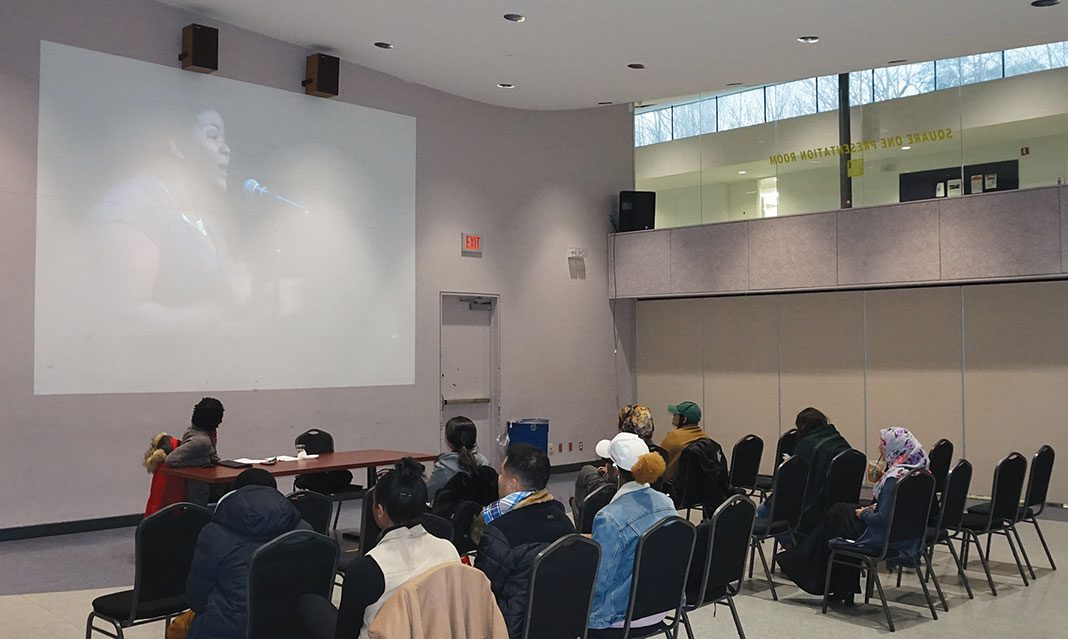“Man up!” “Boys don’t cry!” and “Stop being so sensitive!” are among the many phrases you may hear when a man chooses to break free from his socially-accepted gender role. According to Cornel Grey, a U of T Ph.D. student, when men are faced with this type of ridicule, they often feel the need to prove their masculinity by engaging in an “exaggerative performance of behaviour that is stereotypically male.” Men do this by presenting themselves as overly macho on the outside, while constantly masking their true emotions. This concept can be referred to as hyper-masculinity.
Last Tuesday, Grey came in to talk to students about deconstructing hyper-masculinity as a part of a panel organized by UTMSU and Caribbean Connections. Through an interactive presentation involving personal anecdotes and examples from the media, Grey engaged the audience and discussed the effects of gender norms on society.
By drawing attention to the differences between the ways in which boys and girls are socialized, Grey emphasized just how deeply-rooted some of these gender norms are. Something as simple as choosing what colour to paint a baby’s room is influenced by a preconceived notion of what it means to be masculine or feminine. Sometimes, people can act as unknowing abettors to this seemingly harmless act, accidentally enforcing heteronormative stereotypes in everyday life. Secondary socializers, like the media, also play a large role in promoting the gender narrative.
In the media, hyper-masculinity is often displayed through the portrayal of independent wealth, physical dominance and toughness, physical attractiveness and confidence, and female sexual objectification. Although this depiction of men clearly creates a level of separation among the sexes, what may not be as apparent, is the intersectional divide existing between men of different races.
To emphasize this point, Grey highlighted the differences between the way in which black masculinity and white masculinity is portrayed in the media. White masculinity is often demonstrated through attractive business-type characters who are clean cut, wealthy, and represent success in all aspects of life.
This association with “hegemonic masculinity,” otherwise known as the “accumulation of idealized traits associated with manhood” appears to be reserved for white men only. Black men are simply not given the same opportunities. Instead, they are type-cast as absentee fathers, domestic abusers, or gangsters, promoting the association between black masculinity and failed masculinity.
This discrepancy must also be considered when analyzing the way in which news stories are framed. Reporters often have the tendency to describe black boys as “men” or “thugs,” exaggerating their deviant behaviour, while white men, like the 27-year-old responsible for the Quebec mosque shooting, are described as “boys” or “kids” who didn’t know any better. Although male privilege exists, there are limitations to this privilege, as marginalized groups continue to be treated as lesser than the traditional white male.
Another topic of discussion that Grey brought to light, was the idea of “male tears” and the “crisis of masculinity.” To introduce the topic, Grey played a video of spoken word artist, Imani Cezanne, performing a piece titled “Heels.”
In this poem, Cezanne addresses male height insecurities and makes her assertion about heels quite clear, arguing she should not be made to feel ashamed of her tall stature. Many students in the audience picked up on the significance of this insecurity, as height is often associated with dominance and supremacy. Feeling uneasy about something as insignificant as a woman’s height could be symbolic of a much deeper issue, namely being uncomfortable with the idea of female power. When experiencing this discomfort, men often feel as though their masculinity is being challenged or put into question, they fear being associated with femininity, and feel the need to overcompensate and exert their dominance. The nature of the fear itself demonstrates the extent to which society has internalized the patriarchy.
To wrap up his presentation, Grey turned to the audience in search of a next step. He wanted to ensure that the conversation would extend far beyond the walls of the Student Centre.
Although most students agreed that this idea of hyper-masculinity is toxic and should be deconstructed, a variety of possible solutions were provided.
Some felt as though the potential for change fell in the hands of future generations, arguing that parents today must educate their children and socialize them in a way that puts an end to harmful gender stereotypes. Rather than teach young girls to express themselves, while boys are taught to bottle everything up, both genders should be treated equally. It has been statistically shown that men are less likely to seek mental health assistance and are more likely to commit suicide. If men feel comfortable enough to discuss their feelings, then we can prevent this from happening in the future.
Although educating the future generation is important, other students suggested that the change can begin now. As a group, students brainstormed ways in which they could work toward dismantling gender norms in their own lives. Some students, both male and female, stated that they would shut down sexist commentary that fueled the patriarchy.
But many students realized that small gestures can go a long way. Opening the conversation about gender norms can begin with something as simple as challenging someone who tells you that you “run like a girl.” Grey insisted that together, over time, we can work toward building a more inclusive world that allows people to be whatever they want to be, regardless of sex and gender.



